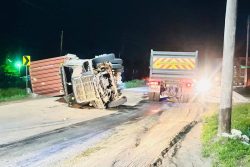Following the discovery on November 25th of 1,100 lbs of cocaine at the Dutch port of Rotterdam in a shipment of Guyanese rum, the authorities here have made concerted efforts to downplay the possibility that the narcotic was stashed in the container while it was in this country.
The problem for the authorities, though, is one of credibility and the consistent failure to stop cocaine exports from this country and prosecute the culpable. The drug ‘war’ at the moment mainly consists of the interception of small-time ganja pushers and cocaine couriers and the burning of marijuana fields. The drug lords remain untouched in their various lairs seemingly assured that they won’t be inconvenienced.
Media in the Netherlands have reported the Public Prosecution Service as stating that the 530 kilos of cocaine were found in gym bags hidden in the container of boxed rum and that it was shipped to Rotterdam via the Dominican Republic. The cargo was destined for a company in Schiedam and the Public Prosecution Service stated that that company appears to have nothing to do with the smuggling.
In its statement of November 30, the Customs Anti Narcotic Unit (CANU) said that the current measures in place “ensure that containers departing the country are scanned. In addition, a physical examination is done when required based on several parameters. The container in question was scanned by the relevant law enforcement agencies, prior to departure and there were no contraband items concealed among the documented cargo”.
It is unclear whether the manner in which the gym bags were positioned amid the boxes would have allowed scanners to detect their presence. It would also appear from the CANU statement that there was no physical inspection of the container prior to departure.
After the container was scanned, CANU said that it was transported to a city wharf where it was “stored in a secure area awaiting departure. Prior to departure as per standard operations procedure, a physical check would have been done to ensure that both the line and custom seals were intact and there was no sign of tampering.”
There should be an investigation to ascertain whether indeed these seals remained intact and weren’t simply cleverly duplicated.
CANU stated that after departing Guyana, the container transited another Caribbean territory – which it did not name – where it was offloaded and remained for a period of five days before it was loaded onto another vessel and shipped to the Netherlands where the discovery was made.
The five days were of course more than sufficient time for the drugs to be inserted into the rum container in the Dominican Republic, a notorious area on drug trafficking routes. That is little comfort to Guyana as it means that its assorted products transiting the Dominican Republic could be at grave risk of being contaminated with cocaine. This was suspected to be the fate of a Guyanese rice shipment last year which was found at the German port of Hamburg with cocaine in it. A formal protest should be lodged with Santo Domingo and the authorities there should be pressed to provide answers.
For its part, the Guyana Revenue Authority (GRA) said on December 3rd that the consignment was scanned in Guyana “according to the stipulated procedures, and no contraband or prohibited/ restricted substances were detected among the said cargo when scanned”.
The GRA added that joint enforcement and intelligence activities with CANU and other local and foreign law enforcement bodies have put in place a system of rigid controls “thereby reducing the probability of narcotic substances being exported or transshipped through Guyana’s ports. This process allows for simultaneous viewing of the scanned images by officers of the sister agencies, and backup checks thereafter prior to shipping”.
The GRA also said that such images are stored and backed-up at various sites thereby reducing the likelihood of a repeat of the deletion of images. This was a reference to the exportation in October last year from Guyana of 11.5 tonnes of cocaine in a container of scrap metal which was intercepted at the Belgian port of Antwerp. The scanned images of this container were deleted by GRA personnel in a damning example of the extent of corruption that attends the drug trafficking trade. More than a year later, the presumptive shipper remains at large and the varied law enforcement units have not been able to enlighten the public here as to how 11.5 tonnes of cocaine escaped their eyes in what Brussels has described as “the largest overseas drug bust ever, worldwide.”
Curiously, the GRA also said on Friday it is willing to have reporters view such images and will shortly allow media representatives to view the scanning process. This would really just be a gimmick as news reporters would be at a loss as to what they are viewing and it’s really a question of GRA personnel doing their job properly and being insulated from enticements from the drug trade.
Interestingly, DDL itself has sought to downplay the possibility that the drugs were planted here. In a release on Saturday headlined `DDL convinced its shipment was not contaminated in Guyana’, the company said that it “is convinced that the various checks and balances executed in Guyana, including its own security mechanisms employed during the stuffing of containers with its product at its Diamond plant, would have detected any illegal substances”.
It may well be the case that the cocaine was introduced in the Dominican Republic which means that Guyana and companies like DDL face serious risks in a global environment where security breaches could lead to severe repercussions.
However, the inability of the authorities to date to explain how 11.5 tonnes of cocaine were shipped out of the country in October last year and the failure to prosecute the operators of what had to be a massive operation leaves much room for doubt. The public would no doubt welcome more information on this latest bust in Rotterdam.








